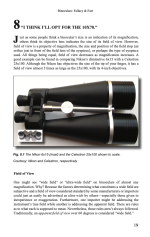Field of view is measured in ONE telescope. Because the size of the objectives and magnification should be exactly the same. If the second telescope does not equal that,
1) The specs have been reported incorrectly,
2) The binocular is out of collimation (alignment),***
3) One or more elements is over or undersized compared to specs,
4) One or more baffles or field stops is over or under specs. These days that rarely happens and is nothing to worry about. Although a few observers seem to fixate on scientifically insignificant anomalies because it gives them something seemingly important to talk about.
5) The perceived problem is physiological and has NOTHING to do with the binocular.
Another example would be that LIGHT GRASP would equal the light grasp of BOTH objectives combined. That is totally REASONABLE. Also totally wrong! It may be right mathematically. However, the brain does not work on mathematics. A second objective allows for an increase in “perceived” light grasp that few people would even notice.
*** “perfectly collimated.” Of the several thousand I have collimated, none have been “perfectly” collimated. Any binocular can be collimated “perfectly collimated for all practical purposes.” However, that condition would be constantly changing due to changes in temperature and humidity. See attached.
Don’t worry; be happy.
Bill





